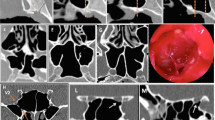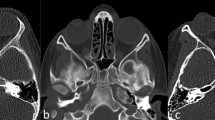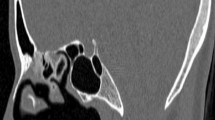Abstract
The sphenoid sinus, one of the posterior groups of sinuses, has long been regarded as a ‘neglected sinus’ due to the anatomical location, poor understanding and poor accessibility, till the advent of endoscopes and modern imaging techniques. Increasing knowledge and greater understanding of this sinus has permitted an evolution in surgical practices and boundaries. Various literatures of the past report a great variety of rates of pneumatization, rates of optic nerve protrusion and dehiscence, as well as internal carotid artery (ICA) protrusion and dehiscence. One similarity noted among these studies is that the rates vary according to the ethnicity of the patients. Recommendations have also been made along the way with regard to modified surgical techniques. This review aims to describe the pneumatization of sphenoid sinus and the topographical relation of the optic nerve and ICA in different populations.



Similar content being viewed by others

References
Abdullah BJ, Arasaratnam S, Kumar G et al (2001) The sphenoid sinuses: computed tomographic assessment of septation, relationship to the internal carotid arteries, and sidewall thickness in the Malaysian population. J HK Coll Radiol 4:185–188
Abuzayed B, Tanriover N, Ozlen F et al (2009) Endoscopic endonasal transsphenoidal approach to the sellar region: results of endoscopic dissection on 30 cadavers. Turk Neurosurg 19(3):237–244
Anon JB, Lipman SP, Oppenheim D et al (1994) Computer-assisted endoscopic sinus surgery. Laryngoscope 104:901–905
Aoki S, Dillon WP, Barkovich AJ et al (1989) Marrow conversion before pneumatization of the sphenoid sinus: assessment with MR imaging. Radiology 172:373–375
Arslan H, Aydinlioğlu A, Bozkurt M et al (1999) Anatomic variations of the paranasal sinuses: CT examination for endoscopic sinus surgery. Auris Nasus Larynx 26(1):39–48
Badia L, Lund VJ, Wei W et al (2005) Ethnic variation in sinonasal anatomy on CT-scanning. Rhinology 43(3):210–214
Bailey et al (1993) Approaches to the sphenoid. In: Head and neck surgery-otolaryngology, 1st edn, vol 1. J.B. Lippincott, Philadelphia, pp 402–412
Bailey et al (1993) Intranasal sphenoidectomy. In: Atlas of head and neck surgery-otolaryngology, 1st edn. J.B. Lippincott, Philadelphia, pp 874–877
Bansberg SF, Harner SG, Forbes G (1987) Relationship of the optic nerve to the paranasal sinuses as shown by computed tomography. Otolaryngol Head Neck Surg 96(4):331–335
Batra PS, Citardi MJ, Gallivan RP et al (2004) Software-enabled computed tomography analysis of the carotid artery and sphenoid sinus pneumatization patterns. Am J Rhinol 18:203–208
Bayram M, Sirikci A, Bayazit YA (2001) Important anatomic variations of the sinonasal anatomy in light of endoscopic sinus surgery: a pictorial review. Eur Radiol 11:1991–1997
Bolger WE, Butzin CA, Parsons DS (1991) Paranasal sinus bony anatomic variations and mucosal abnormalities. Laryngoscope 101:56–64
Bouthillier A, van Loveren HR, Keller JT (1996) Segments of the internal carotid artery: a new classification. Neurosurgery 38(3):4254–4332
Cakur B, Sümbüllü MA, Yılmaz AB (2011) A retrospective analysis of sphenoid sinus hypoplasia and agenesis using dental volumetric CT in Turkish individuals. Diagn Interv Radiol 17(3):205–208
Cavallo LM, de Divitiis O, Aydin S (2007) Extended endoscopic endonasal transsphenoidal approach to the suprasellar area; anatomic considerations: part 1. Neurosurgery 61(3 suppl):24–33
Chapman PR, Shah R, Cure JK et al (2011) Petrous apex lesions: pictorial review. AJR Am J Roentgenol 196(3 suppl)
Chi JW, Brady M, Moore NR et al (2011) Fusion of perpendicular anisotropic MRI sequences. IEEE Int Symp Biomed Imaging 1455–1458
Cho JH, Kim JK, Lee JG et al (2010) Sphenoid sinus pneumatization and its relation to bulging of surrounding neurovascular structures. Ann Otol Rhinol Laryngol 119(9):646–650
Chong VFH, Fan YF, Lau D et al (1998) Functional endoscopic sinus surgery (FESS): what radiologists need to know. Clin Radiol 53:650–658
Ciric I, Ragin A, Baumgartner C et al (1997) Complications of transsphenoidal surgery: results of a national survey, review of the literature, and personal experience. Neurosurgery 40:225–236
Davis WE, Templer J, Parsons DS (1996) Anatomy of the paranasal sinuses. Otolaryngol Clin N Am 29:57–74
Davoodi M, Saki N, Saki G et al (2009) Anatomical variations of neurovascular structures adjacent sphenoid sinus by using CT scan. Pak J Biol Sci 12:522–525
DeLano MC, Fun FY, Zinreich SJ (1996) Relationship of the optic nerve to the posterior paranasal sinuses: a CT anatomic study. Am J Neuroradiol 17(4):669–675
Dessi P, Moulin G, Castro F et al (1994) Protrusion of the optic nerve into the ethmoid and sphenoid sinus: prospective study of 150 CT studies. Neuroradiology 36(7):515–516
Divitiis ED, Esposito F, Cappabianca P et al (2008) Endoscopic transnasal resection of anterior cranial fossa meningiomas. Neurosurg Focus 25(6):E8:1–E8:8
Doshi J, Youngs R (2007) Navigational systems in rhinology: should we all be using them? J Laryngol Otol 121:818–821
Driben JS, Bolger WE, Robles HA et al (1998) The reliability of computerized tomographic detection of the Onodi (sphenoethmoid) cell. Am J Rhinol 12:105–111
Elwany S, Yacout YM, Talaat M et al (1983) Surgical anatomy of the sphenoid sinus. J Laryngol Otol 97:227–241
Filho BCA, Neto CDP, Weber R et al (2008) Sphenoid sinus symmetry and differences between sexes. Rhinology 46:195–199
Fuji K, Chambers SM, Rhoton AL Jr (1979) Neurovascular relationships of the sphenoid sinus. A microsurgical study. Neurosurgery 50:31–39
Fried MP, Parikh SR, Sadoughi B (2008) Image-guidance for endoscopic sinus surgery. Laryngoscope 118:75–80
Greenfield JP, Anand VK, Kacker A et al (2010) Endoscopic endonasal transethmoidal transcribriform transfovea ethmoidalis approach to the anterior cranial fossa and skull base. Neurosurgery 66(5):883–892
Gupta AK, Lynrah ZA, Kalsotra G (2009) Invasive sino-aspergillosis in immunocompetent individuals: atypical presentations. AIJCR 2(3):27–31
Gupta T, Aggarwal A, Sahni D (2013) Anatomical landmarks for locating the sphenoid ostium during endoscopic endonasal approach: a cadaveric study. Surg Radiol Anat 35(2):137–142
Hamid O, Fiky LE, Hassan O et al (2008) Anatomic variations of the sphenoid sinus and their impact on trans-sphenoid pituitary surgery. Skull Base 18(1):9–15
Hammer G, Radberg C (1961) The sphenoidal sinus. An anatomical and roentgenological study with reference to transsphenoid hypophysectomy. Acta Radiol 56:401–422
Hewaidi G, Omami G (2008) Anatomic variation of sphenoid sinus and related structures in Libyan population: CT scan study. Libyan J Med 3(3):128–133
Hernández GM, Lorduy TC, García MJV et al (2011) Revision of surgical treatment of rhinosinusitis. Acta Otorrinolar 62(1):56–64
Hidir Y, Battal B, Durmaz A et al (2011) Optimum height from the roof of the choana for seeking the sphenoid ostium. J Craniofac Surg 22(3):1077–1079
Kayalioglu G, Govsa F, Erturk M et al (1999) The cavernous sinus: topographic morphometry of its contents. Surg Radiol Anat 21(4):255–260
Kazkayasi M, Karadeniz Y, Osman KA (2005) Anatomic variations of the sphenoid sinus on computed tomography. Rhinology 43:109–114
Keskin G, Ustündag E, Ciftçi E (2002) Agenesis of sphenoid sinuses. Surg Radiol Anat 24(5):324–326
Kim HU, Kim SS, Kang SS (2001) Surgical anatomy of the natural ostium of the sphenoid sinus. Laryngoscope 111:1599–1602
Kingdom TT, Delgaudio JM (2003) Endoscopic approach to lesions of the sphenoid sinus, orbital apex and clivus. Am J Otolaryngol 24(5):317–322
Lang J (1989) Clinical anatomy of the nose, nasal cavity and paranasal sinuses. Thieme Medical Publishers, New York
Lanza DC, Kennedy DW (1993) In: Ballery Byron J (ed) Endoscopic sinus surgery in head and neck surgery-otolaryngology. J.B. Lippincott, Philadelphia, pp 389–398
Lanzieri CF, Shah M, Krauss D et al (1991) Use of gadolinium-enhanced MR imaging for differentiating mucocoeles from neoplasms in the paranasal sinuses. Radiology 178:425–428
Laws ER Jr (1999) Vascular complications of transsphenoidal surgery. Pituitary 2:163–170
Lehmann P, Bouaziz R, Page C et al (2009) Sinonasal cavities: CT imaging features of anatomical variants and surgical risk. J Radiol 90(1 Pt 1):21–29
Madiha AES, Raouf AA (2007) Endoscopic anatomy of the sphenoidal air sinus. Bull Alex Fac Med 43:1021–1026
Mafee MF, Chow JM, Meyers R (1993) Functional endoscopic sinus surgery: anatomy, CT screening, indications and complications. AJR 160:735–744
Martin TJ, Smith TL, Smith MM et al (2002) Evaluation and surgical management of isolated sphenoid sinus disease. Arch Otolaryngol Head Neck Surg 128:1413–1419
Melhem ER, Oliverio PJ, Benson ML et al (1996) Optimal CT evaluation for functional endoscopic sinus surgery. Am J Neuroradiol 17:181–188
Meloni F, Mini R, Rovasio S et al (1992) Anatomic variations of surgical importance in ethmoid labyrinth and sphenoid sinus. A study of radiological anatomy. Surg Radiol Anat 14(1):65–70
Metson R, Richard E, Gliklich RE (1996) Endoscopic treatment of sphenoid sinusitis. Otolaryngol Head Neck Surg 114:736–744
Momeni AK, Roberts CC, Chew FS (2007) Imaging of chronic and exotic sinonasal disease: review. AJR Am J Roentgenol 189(6 suppl)
Ng YH, Sethi DS (2011) Isolated sphenoid sinus disease: differential diagnosis and management. Curr Opin Otolaryngol Head Neck Surg 19:16–20
Pifferi M, Bush A, Caramella D et al (2011) Agenesis of paranasal sinuses and nasal nitric oxide in primary ciliary dyskinesia. EJR 37(3):566–571
Sapçi T, Derin E, Almaç S et al (2004) The relationship between the sphenoid and the posterior ethmoid sinuses and the optic nerves in Turkish patients. Rhinology 42(1):30–34
Sareen D, Agarwal AK, Kaul JM et al (2005) Study of sphenoid sinus anatomy in relation to endoscopic surgery. Int J Morphol 23(3):261–266
Scuderi AJ, Harnsberger HR, Boyer RS (1993) Pneumatization of the paranasal sinuses: normal features of importance to the accurate interpretation of CT scans and MR images. AJR Am J Roentgenol 160(5):1101–1104
Sethi DS, Stanley RE, Pillay PK (1995) Endoscopic anatomy of the sphenoid sinus and sella turcica. J Laryngol Otol 109(10):951–955
Sethi DS (1999) Isolated sphenoid lesions: diagnosis and management. Otolaryngol Head Neck Surg 120:730–736
Sinnathamby CS (2006) Last’s anatomy, regional and applied, 11th edn. Churchill Livingstone Elsevier, UK
Sirikci A, Bayazit YA, Bayram M et al (2000) Variations of sphenoid and related structures. Eur Radiol 10(5):844–848
Sonbay D, Saka C, Akin I et al (2010) Prevalence of sphenoid sinus agenesis in adults: a CT scan study. B-ENT 6(3):167–169
Stammberger H (1991) Functional endoscopic sinus surgery: the Messerklinger technique. BC Decker, Philadelphia
Stammberger H, Hawke M (1993) Essentials of functional endoscopic sinus surgery. Mosby-Year Book Inc, St Louis
Steven D (1990) Endoscopic sinus surgery: posterior approach. Oper Tech Otolaryngol Head Neck Surg 1:104–107
Synderman CH, Pant H, Carrau RL et al (2009) What are the limits of endoscopic sinus surgery?: the expanded endonasal approach to the skull base. Keio J Med 58(3):152–160
Tan HK, Ong YK (2007) Sphenoid sinus: an anatomic and endoscopic study in Asian cadavers. Clin Anat 20(7):745–750
Turgut S, Gumusalan Y, Arifoglu Y et al (1996) Endoscopic anatomic distances on the lateral nasal wall. J Otolaryngol 25:371–374
Unal B, Bademci G, Bilgili YK et al (2006) Risky anatomic variations of sphenoid sinus for surgery. Surg Radiol Anat 28(2):195–201
Van Alyea OE (1941) Sphenoid sinus. Anatomic study, with consideration of the clinical significance of the structural characteristics of sphenoid sinus. Arch Otolaryngol 34:225–253
Wang J, Bidari S, Inoue K et al (2010) Extensions of the sphenoid sinus: a new classification. Neurosurgery 66:797–816
Wigand ME, Iro H, Bozzato A (2009) Transcranial combined neurorhinosurgical approach to the paranasal sinuses for anterior skull base malignancies. Skull Base 19(2):151–158
Conflict of interest
None declared.
Author information
Authors and Affiliations
Corresponding author
Rights and permissions
About this article
Cite this article
Anusha, B., Baharudin, A., Philip, R. et al. Anatomical variations of the sphenoid sinus and its adjacent structures: a review of existing literature. Surg Radiol Anat 36, 419–427 (2014). https://doi.org/10.1007/s00276-013-1214-1
Received:
Accepted:
Published:
Issue Date:
DOI: https://doi.org/10.1007/s00276-013-1214-1



